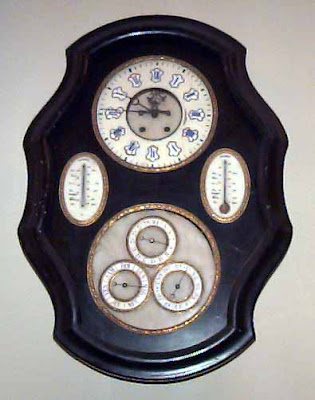
It was inaugurated in 1963, in a hall belonging to the Culture Palace, by the care of professor Nicolae Simache, manager of History Museum between 1954-1971. Subsequently, the collection of clocks was brought into a building that had been constructed at the end of the 19th century; it belonged to Luca Elefterescu, a well-known conservative politician during the early decades of the 20th century, with several mandates of prefect of Prahova County.
Those who visit the museum have the occasion to follow the way in which the means of measuring the time had developed, from the first "clocks"- the sun dial, the burning clocks, the clocks with water (the outline of the clock with water being taken over from d'Horologerie Ancienne) or the clocks with sand - up to the ancient mechanical clocks and modern ones. These wonderful works of horology are, often, not only the products of well-known horologists, but of men of art as well, who contributed in the way that they made the clocks as attractive as they could, creating even styles in this domain. Among the oldest pieces of the collection we name the and type pendulums, made of golden bronze, engraved or cut, sometimes with enameled dials. The oldest of the clocks, dated 1562, additionally asserts the inter crossing of preoccupations for calculating time and for astronomy, as it has astronomical dials.

Among the most valuable works of the museum's collection are the pendulums, with long cabinets and rich chiseled bronze decorations, gold pieces, exotic veneer or inlaid work. The symbols are present: the sun, the time, the child with the hourglass in his hand. The metal dial is ornate in its turn, with little enamel plates on which the ciphers are engraved. The rococo style is underlined by a few works: one of them had been created in Paris at Brulfer, in the 18th century having a wooden painted case, another work, of small dimensions, molded in brass thin paper, is decorated with a polychrome enamel painting, showing a gallant scene.

The hearth pendulum Louis XVI is another type of clock that can be identified in the museum's halls. It brings the note of refined feeling that appeared in the artistic taste during the second half of the 18th century. The urn like clock, made of Sèvres porcelain, the pendulum with venata marble columns or the small table lock suspended between colonnades, covered with an encaille enamel are some of the most beautiful exemplars of the collection. Most of the time, elements belonging to this style are found along other ornaments that belong to various artistic styles, producing that composite order, so characteristic for the 19th century.

The hall pendulums created in the Empire style, distinguish through the plasticity of feminine figures, the refined work done with the chisel and the grandeur of the artistic composition. The exhibition would not be complete without "the paintings with clocks", an attribute of the Biedermeier style. The German horologists became famous at the beginning of the 18th century by making the wall pendulums, with hand made mechanisms, kept in artistically sculpted cases, with flora and fauna motives, and birds announcing the hours. The folk influence inspired the creation of the wall clocks in straight cases, made by lathering. Some of them were created in Romania, having German or Austrian mechanisms.

The pocket watches belonging to the museum's collection are the expression of the way in which science, technique and art have contributed to the creation of one of the finest and most minute machinery. In the history of the pocket watch, invented around 1500 by Peter Henlein from Nuremberg, other names of celebrated horologists will be inscribed: Ralf Gout, Th. With, George and Edward Prior, Benjiamin Balber and others, as well as firms producing clocks/watches, which appear in impressive number beginning with the half of the 20th century.

Among the most valuable works are the hand-made clocks, created by great English, French and Dutch horologists. They reveal mechanisms of functioning, winding ringing and they were carefully created in the 17th and the 18th centuries. The chain spindle mechanism would frequently appear, being continuously improved. The gong or bell ringing belongs, also, to the beginning of the mechanical horology. Another characteristic of these clocks is the metal dial. The protection case, most of the times made of silver or baga, deep shaped (of Byzantine type), is composed of three lids. Since the first pocket watches had been made up to the moment when prestigious firms, such as Schaffhausen, Omega, Zenith, Patek Philippe and other began to create clocks, there is a span of time of two centuries. All this time the clocks reached to a high level of technical and artistic expression.

The jewel clocks, artfully created, are made of gold or silver, decorated with exquisite engravings and precious stones or with enamels of different nuances. The clocks are painted or decorated with floral, geometrical motives etc. Distinguished by their beauty, are the clocks that belonged to the Romanian kings Carol I and Carol II, those of Tzar Alexander II, the clock of the poet Vasile Alecsandri and the pendant clock of Mihail Kogalniceanu's daughter, as well as the pieces that came from the firms Genevieve Sandoz, Oudin and others. A special lace is occupied by the clocks of great personalities of the Romanian culture and political life: Constantin Brâncoveanu, Alexandru Ioan Cuza, Cezar Bolliac, Bogdan Petriceicu-Haşdeu, Ion Luca Caragiale, Duiliu Zamfirescu, Ioan Al. Bassarabescu, Alexandru Moruzzi, Mihail Kogalniceanu, Theodor Aman, Nicolae Iorga, Păstorel Teodoreanu and others.

The collection also contains some curious clocks, such as: "the invisible clock", with transparent dial and a hidden-in-frame mechanism; the "steam factory" (in miniature) made in Paris in 1800; the miller's clock, the barber's clock, the umbrella-clock, created in England; the painting-clock with mobile figurines or the stamp-clock. A last surprise for the visitors of Clock Museum, the musical boxes, which function with the help of a mechanism similar to that of a clock. The invention is dated at the end of the 19th century, when in Europe and America the devices for musical recordings began to get known.











No comments:
Post a Comment